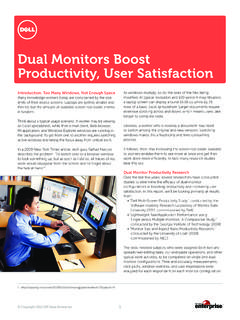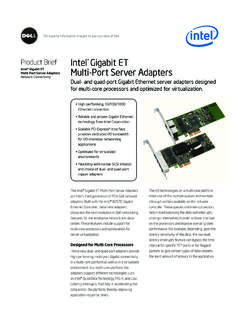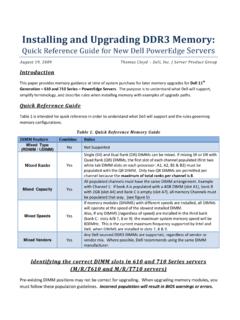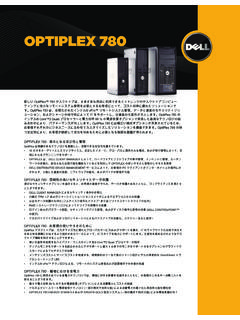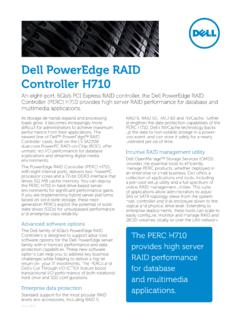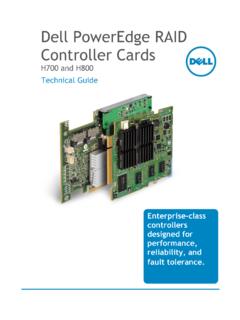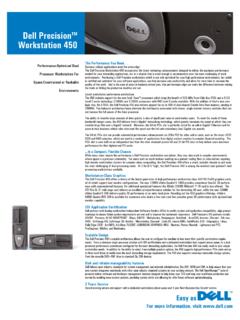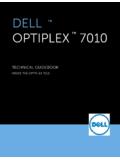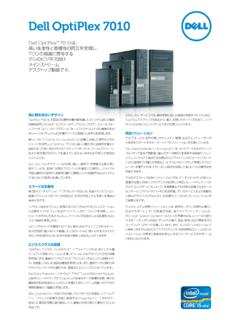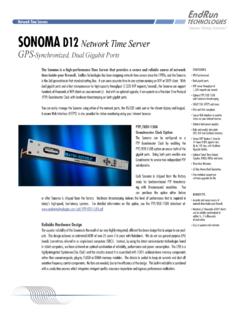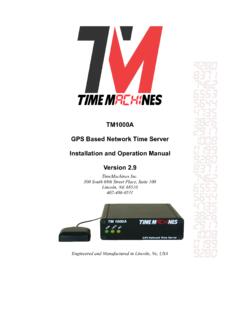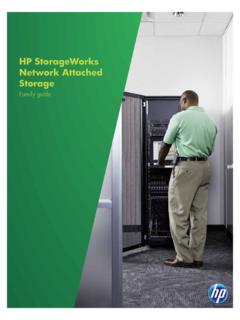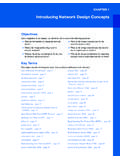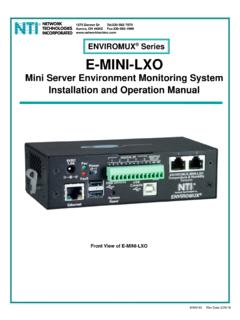Transcription of Dell PowerEdge Select Network Adapters The …
1 dell PowerEdge Select Network Adapters The Freedom to Choose This feature overview describes the dell PowerEdge Select Network Adapters family, also known as Network Daughter Cards (NDCs). Rich Hernandez Pankaj Gupta Rahul Deshmukh Nick Harris dell PowerEdge Select Network Adapters The Freedom to Choose ii Contents Abstract .. 3 Changes in server interconnectivity .. 3 The need for LOM 4 Choosing which NDC to use .. 5 Available NDC options .. 6 1 GbE port features .. 8 ISCSI boot .. 8 Energy Efficient Ethernet (EEE) .. 8 10GE port features .. 8 ISCSI boot .. 9 iSCSI HBA .. 9 Fiber Channel over Ethernet (FCoE) .. 9 Data Center Bridging (DCB) .. 10 Enhanced Transmission Selection .. 10 Priority-based Flow Control .. 10 Data Center Bridging Capability Exchange Protocol .. 10 Multiple Receive Queues .. 11 Switch Independent Partitioning .. 11 SR-IOV ready.
2 12 Supported system interfaces .. 13 PCIe interface .. 13 NC-SI interface .. 13 I2C interface .. 14 PowerEdge platforms that support Select Network Adapters .. 14 System integration .. 14 Device Disable .. 14 Wake on LAN .. 14 iDRAC integration .. 14 Form factors .. 15 Blade Select Network Adapters .. 15 Rack Select Network Adapters .. 15 4 x 1G NDC .. 16 2 x 1G + 2 x 10G SFP+ NDC .. 16 Conclusion .. 17 Appendix A: Industry specifications .. 18 Appendix B: Acronyms .. 18 Appendix C: 10GE Connectivity Options .. 19 This document is for informational purposes only, and may contain typographical errors and technical inaccuracies. The content is provided as is, without express or implied warranties of any kind. 2012 dell Inc. All rights reserved. dell and its affiliates cannot be responsible for errors or omissions in typography or photography. dell , the dell logo, and PowerEdge are trademarks of dell Inc.
3 Intel is a registered trademark of Intel Corporation in the and other countries. Other trademarks and trade names may be used in this document to refer to either the entities claiming the marks and names or their products. dell disclaims proprietary interest in the marks and names of others. January 2012 | Rev dell PowerEdge Select Network Adapters The Freedom to Choose 3 Abstract The twelfth-generation dell PowerEdge server portfolio uses a dell custom daughter card to house the complete LAN on Motherboard (LOM) subsystem. In these systems, the LOM is provided on the Network Daughter Card (NDC) as part of dell PowerEdge Select Network Adapters family. There are two form factors of Select Network Adapters , one for blade servers and one for rack servers. The Blade Select Network adapter provides dual port 10 GbE from various suppliers. The Rack Select Network adapter provides a selection of 1 GbE and 10 GbE port options, such as 1000 Base-T, 10 GBASE-T and 10Gb SFP+.
4 The Select Network adapter form factor continues to deliver the value of LOM integration with the system, including BIOS integration and shared ports for manageability while providing flexibility. Changes in server interconnectivity Historically, servers have provided a fixed LAN on Motherboard (LOM) subsystem integrated directly on the main system planar as the primary Network access. This provided a fixed physical layer interconnect, typically One Gigabit Ethernet, and a fixed number of ports. This has served customers well until the advent of high-speed 10 GbE technologies, which now provide significant benefits and physical-layer interface choices. As server designs have become more dense, it has become inevitable that the built in LOM would give way to offer more flexibility. Mainstream servers are now requiring 10 Gigabit per second interfaces with added demand for more flexibility from the LOM slot.
5 dell has listened to our customers and is now offering a flexible approach to the LOM on our rack and blade mainstream Power Edge servers. server virtualization, Network convergence, and space efficiency are three primary factors driving the need for flexibility on the choice of LOM subsystem. In addition, each factor drives the need for higher bandwidth interconnects, such as 10 GbE and 40 GbE. The server Network interconnect landscape has changed significantly. The following points, along with Figure 1, help to explain these changes. The transition to 10 GbE has begun with various physical interface choices. Both copper and optical choices are needed, including 10 GBASE-T and SFP+ optical and Direct Copper Attached. 10 GBASE-T is the physical interconnect of choice for installations requiring long cable runs (for example, >10 m). SFP+ and Direct Copper Attached is the current preference for top-of-rack 10 GbE connectivity, but we expect many installations to shift to 10 GBASE-T in the future.
6 In addition, XAUI-to-KR transition is driven by blade infrastructure to provide 10 GbE on all fabrics. Network convergence (iSCSI and FCoE [Fibre Channel over Ethernet]) and virtualization is driving an ever richer feature set that offer choice of capabilities and performance. The need for higher space efficiency, or the ability to do more with the same or smaller space, means the Network fabric taken by the LOM must be able to do more than just networking via Ethernet. dell PowerEdge Select Network Adapters The Freedom to Choose 4 Traditional networking and storage server I/O is converging, broadening the supplier choice. The Select Network adapter provides link speed choice, Network interface choice, and vendor choice. Figure 1. The server interconnect landscape The need for LOM flexibility dell s unique PowerEdge Select Network Adapters family has a lot of benefits.
7 You can respond to a Network infrastructure upgrade in mid- server cycle with full dell management integration. It is also possible to transition from 1 GbE to 10 GbE and to converged 10 GbE without having to replace servers. The transition from optical to copper Network connectivity can be done easily as well. With customers starting to ask for convergence options, it is now possible to deploy full end-to-end convergence without having to rip and replace servers. Networking solutions can be selected depending upon the requirements, and not limited by existing infrastructure, which has not been possible with traditional LOM designs in the current market. This unique feature gives control back to you to choose the best-of-breed technology which best fits your requirements, and it does not require you to pay for something that you will not use. dell has chosen the Select Network adapter to deliver a choice of LOMs.
8 This includes traditional LOM networking capabilities, as well as a new CNA storage functionality. Given the broad spectrum of vendors and capabilities, there is no single solution that addresses all customer needs and priorities. Some solutions are better at core networking functionality at lower power, while others deliver best converged performance. The Select Network adapter family provides a set of flexible vehicles to transition from 1 GbE to 10 GbE. By offering 10Gb port devices as well as 1Gb and 10Gb devices on the same NIC, you can maintain legacy 1Gb connectivity while providing 10Gb availability for new Link transitions 1 GbE to 10 GbE to 40 GbE More 10GE physical options 10 GBASE-T SFP+ DCA SFP+ SR 10 GBASE-KR More capabilities iSCSI, FCoE, SR-IOV, NPAR, DCB, EEE, TLV More converged suppliers Networking: Intel, Broadcom Storage: QLogic, Emulex, Brocade dell PowerEdge Select Network Adapters The Freedom to Choose 5 functions and workloads.
9 This allows adaptation to technology changes during server generations, such as 40 GbE and multi-port 10 GbE. dell s rack Select Network adapter options include quad-port 1 GbE and 10 GbE options. 10 GbE options include two ports of 10 GbE and two ports of 1 GbE to support a variety of use cases for server interconnect. For example, the 1 GbE ports on the rack server NDC could be used for remote management or for Wake on LAN (WoL). dell s blade Select Network adapter provides dual-port 10 GbE interfaces. dell chose to offer only 10 GbE Network Daughter cards for blades due to faster adoption of 10Gb, convergence, and its cost advantages. The cost advantages are due to no dependence of optics transceivers and aggregation via chassis switches. dell provides a choice of LOMs that can increase the operational efficiency and longevity of servers, thereby providing investment protection.
10 Servers do not need to be replaced if IO requirements change, but the servers can be better utilized, allowing you to react faster to a changing networking technology landscape. An IO device can be replaced with a new NDC, which provides more benefits than the traditional LOM. These Adapters are fully managed by the dell Universal server Configurator (USC) for device configuration, updates, and real-time monitoring. All Select Network Adapters can be monitored in real time, utilizing dell Embedded Management through iDRAC. Choosing which NDC to use Choosing a blade server NDC depends on which features are required: Offloads Convergence Virtualization Switch Independent Partitioning Bandwidth requirements Choosing a rack server NDC also depends on a number of factors, such as: Link bandwidth requirements: 1 Gbps or 10 Gbps If 10GE is required, then SFP+ or 10 GBASE-T is needed Feature requirements such as: o Offloads o Convergence o Virtualization o Switch Independent Partitioning dell has also provided information on key strengths and features of these NDCs when a customer is configuring a server for purchase.
